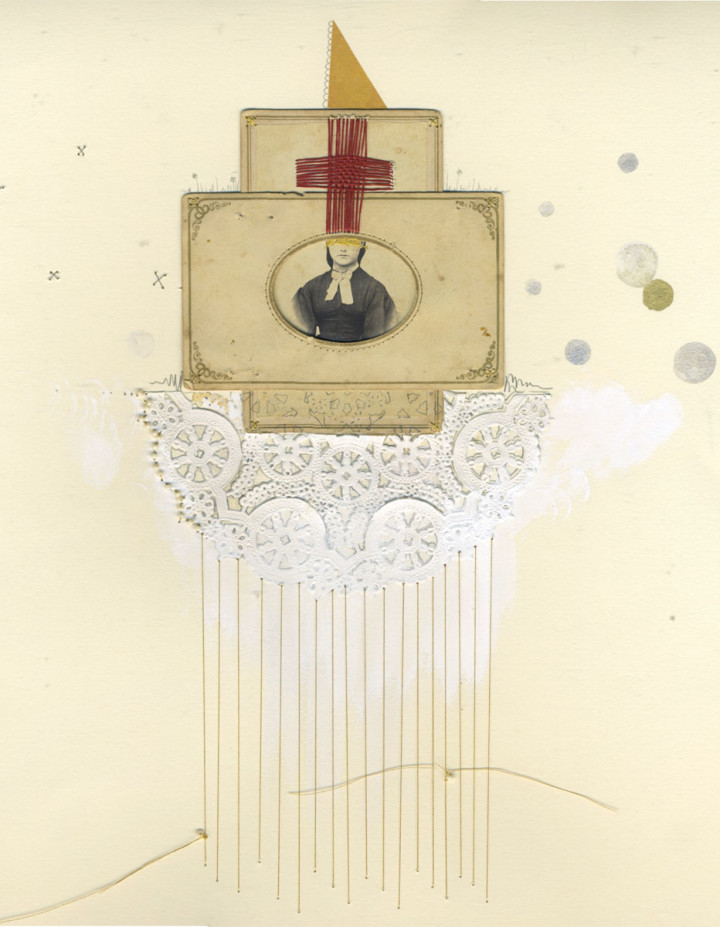In the Compound Studio Artist Gallery
June 6th – July 12th, 2015
Invisible Forces – Amy Burek and Kate Mink
Curated by Toni Gentilli
Microbes and memory can both play tricks on a person’s senses prompting one to
momentarily act, think, or feel differently – unlike themselves – be it through an
undetected illness or ambiguous yet intense recollection. Genetic code and
photographs, on the other hand, reaffirm who we are in a conspicuous, tangible way,
as physical evidence of evolution, familial lineage, and personal history. Two
mixed-media artists, Amy Burek and Kate Mink use these corporeal phenomena to
creatively manifest the invisible forces that influence us, whether hereditary or
imaginary. Although these artists’ subject matter seem at odds with one another, they
are equally mysterious and awe-inspiring. Together, Burek and Mink reveal that perhaps
the distinction between the magic of twenty-first century biosciences and the beliefs of
nineteenth century Spiritualism is less perceptible than we thought.
Amy Burek creates what at first glance appear to be straightforward silkscreen and
letterpress prints unencumbered by extraneous decoration. Burek’s work, however, is
anything but matter-of-fact. The imagery and information she layers together derive
from her years working in microbiology. Through her art, Burek slyly offers insight into the
horrifying and humorous aspects of the unseen world of bacteria, DNA, and biotoxins.
Take for example the piece, Actinomycetales. The phrase “The Scent of Rain” is printed
in sky blue across a halftone of an extreme close-up image captured beneath the lens
of a scanning electron microscope. The work’s title refers to a soil-dwelling bacteria that
produces an organic compound called geosmin, which is the source of the scent we
associate with a summer storm. A related piece depicts Pseudomonas syringae, an
airborne bacteria naturally present in the atmosphere. Scientists have determined that
it is an ice-nucleating pathogen capable of inducing freezing conditions required for
cloud formation and precipitation at warmer temperatures than inorganic particulate
matter alone. Proteins isolated from Pseudomonas syringae are used in cloud seeding
and artificial snow manufacture, proving that although it is impossible for us mere
mortals to control the weather, with the help of bacteria, we can make it rain.
Kate Mink constructs wistful mixed-media collages with found antique photographs and
other historic ephemera. Her delicate work is tinged with equal parts beauty and
melancholy, like Victorian mourning art made with human hair twisted and woven into
impossibly ornate designs that often enshrouded images of loved ones lost. Mink
transforms anonymous portraits into familiars, shadowy silhouettes of possibly known but
imperfectly remembered spirits from another time. She sews and screenprints onto them
ectoplasm-like emanations and gilded auras reminiscent of Spirit Photography. Her
work conjures the power that photographic images once held over us with the valency
of a physical imprint, the light-traced visages of kith and kin to be held, cherished, and
kept safely in a vest pocket or in the clasp of a locket, close to one’s heart. Mink’s
clever use of carte de visites (personal calling cards that predate the internet, but in
retrospect, functioned like an analog Facebook) demonstrates the imperceptible allure
of charismatic personalities, regardless of our relation to them, our historic fascination
with celebrity and self-aggrandizement, as well as an ongoing obsession with taking
and collecting photographic images.

